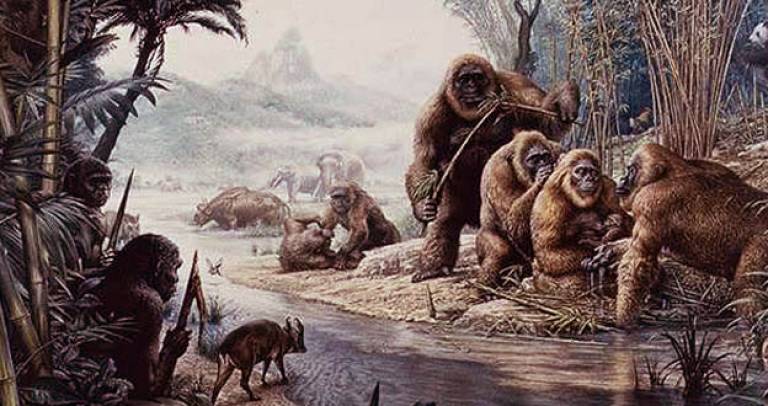Gigantopithecus blacki - The Story So Far
27 March 2017
Gigantopithecus blacki is the largest hominoid that ever lived.
 The consensus view is that it is a specialized pongine and late-surviving member of the Sivapithecus-Indopithecus lineage. It is known primarily from Early and Middle Pleistocene cave sites in southern China, dating from 2.0 Ma to almost 300 ka. The cause of its extinction in the late Middle Pleistocene is unknown, but ecological change or the arrival of Homo erectus may have been contributing factors. Gigantopithecus is highly specialized in its dentognathic anatomy, with a unique combination of features that distinguish it from all other hominoids. Based on the size of its dentition and mandible, a reasonable estimate of its body mass would be 200-300 kg. There was a progressive increase in dental size from the Early Pleistocene to the Middle Pleistocene, and possibly a shift towards greater complexity of the cheek teeth. Gigantopithecus exhibits a relatively high degree of sexual dimorphism, implying a high level of male-male competition, but the relatively small canines in both sexes suggest that these teeth were not important in agonistic behaviors. The species inhabited a subtropical monsoon forest with a closed canopy and dense understory. Foraging was focused on the forest floor and its diet included a broad range of C3 plants, including fruits, leaves and stems, and possibly tubers. The cheek teeth and jaws were adapted for processing a wide variety of bulky, fibrous, and abrasive food items, but the small incisors indicate that incisal preparation was not an important part of its feeding repertoire.
The consensus view is that it is a specialized pongine and late-surviving member of the Sivapithecus-Indopithecus lineage. It is known primarily from Early and Middle Pleistocene cave sites in southern China, dating from 2.0 Ma to almost 300 ka. The cause of its extinction in the late Middle Pleistocene is unknown, but ecological change or the arrival of Homo erectus may have been contributing factors. Gigantopithecus is highly specialized in its dentognathic anatomy, with a unique combination of features that distinguish it from all other hominoids. Based on the size of its dentition and mandible, a reasonable estimate of its body mass would be 200-300 kg. There was a progressive increase in dental size from the Early Pleistocene to the Middle Pleistocene, and possibly a shift towards greater complexity of the cheek teeth. Gigantopithecus exhibits a relatively high degree of sexual dimorphism, implying a high level of male-male competition, but the relatively small canines in both sexes suggest that these teeth were not important in agonistic behaviors. The species inhabited a subtropical monsoon forest with a closed canopy and dense understory. Foraging was focused on the forest floor and its diet included a broad range of C3 plants, including fruits, leaves and stems, and possibly tubers. The cheek teeth and jaws were adapted for processing a wide variety of bulky, fibrous, and abrasive food items, but the small incisors indicate that incisal preparation was not an important part of its feeding repertoire.
Gigantopithecus blacki: a giant ape from the Pleistocene of Asia revisited
Yingqi Zhang, Terry Harrison
DOI: 10.1002/ajpa.23150
 Close
Close

